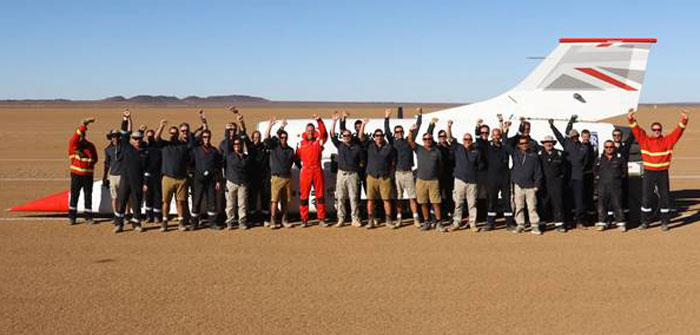The Bloodhound Land Speed Record (LSR) team is due to head home following an extremely success period of high-speed testing in South Africa that concluded with the team putting the vehicle through its paces on a 12-mile stretch of dry lakebed called the Hakskeenpan in the Kalahari Desert. To conduct the tests, a 500m by 16km strip on the alkali playa was cleared of stones and had 20 straight lines painted along its length.
The first phase of the record attempt was focused purely on gathering information on how the car behaved at transonic speeds. Driver Andy Green ended up going faster than intended on his final run. “I’m absolutely delighted with our first 600mph run but personally I’m a tiny bit miffed because my job was to control the car as precisely as possible and take it to 605,” Green said. “When I took my foot off the throttle, the engine gave me power for another half second or so and pushed us up to 628mph. The point is that the jet engine’s performance changes above 600, so lesson learned for next time. All that said, this is a good result to go home with.”
The car is covered with pressure tappings, strain gauges, temperature sensors and accelerometers to provide data on how it reacts under extreme loads at high speed. After every run, the team checked the data against their computer-generated predictions from computational fluid dynamics (CFD) tests. The team was delighted to learn that there was a 90%+ correlation between the expected and actual data, which is extremely encouraging given that they will return to the desert next year with the extra power of a Norwegian Nammo rocket mounted beneath the EJ200 jet engine.
“With the data we’ve generated from the high-speed testing, we’re able to start budgeting for the next phase of the project, which will need to be funded through sponsorship,” said Bloodhound LSR owner Ian Warhurst. “We know it will require up to £10m (US$13m) and the incredible social engagement with our testing program has proved that sponsors will see a return on investment and be a part of history as we develop the monopropellant rocket and prepare the car for supersonic speeds.”
Having achieved the sixth-fastest speed ever recorded by a car, the Bloodhound team will ship the vehicle back to the UK before making an attempt to achieve the land speed record in the next 18 months.


